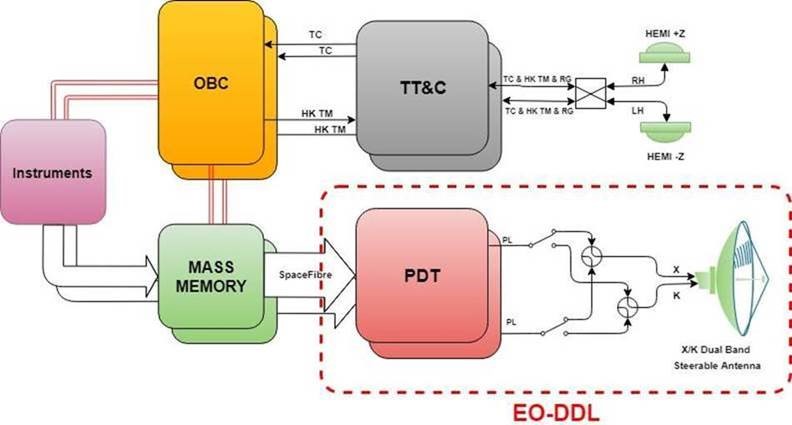InCubed and SENER Aeroespacial’s EO-DDL development continues apace
Eight months after kick off, the EO-DDL payload data transmission system is currently undergoing prototype construction. Designed to meet the downlink requirements of tomorrow’s Earth observation satellites, the InCubed co-funded activity is well on the way to reaching a key Technology Readiness Level milestone.
With the rapid transformation of the Earth observation sector, satellites are increasingly being launched in large constellations with payloads of next-generation sensors producing considerable volumes of data. This presents significant challenges for data transmission, as the growth in spacecraft numbers leads to congestion of frequency bands and current hardware struggles to keep up with payload data-rate requirements.
ESA has proposed to alleviate the problem of overcrowded airwaves by moving the frequency range for sensor data from the X-band (8.025-8.4 GHz) to the K-band (25.5-27 GHz). While the K-band has the advantage of a greater bandwidth, it does bring its own challenges, such as requiring highly directional beams and complex signal modulation to cope with the infamous ‘rain fade’ effect.
Responding to these trends and technical requirements, SENER Aeroespacial is developing a bespoke, future-proof solution for satellite-to-ground-station data transmission: the Earth Observation Data DownLink system (EO-DDL). The EO-DDL consists of a Payload Data Transmitter (PDT) unit in tandem with a Dual Band Steerable Antenna (DBSA) assembly. The system can transmit in both X and K-band and will handle data rates of over 2.6 Gb/s per channel.

Building on a feasibility study it previously carried out for ESA, SENER is now working under an InCubed contract to develop the product further. “Collaborating on this InCubed activity is an exciting opportunity for SENER, as it will enable us to meet the increasing demands for high-throughput LEO-to-ground communication in institutional and commercial EO markets. We’re very happy to contribute to cross-fertilisation within ESA by extending the experience we’ve gained in the Science Programme to Earth observation. We’re also hoping to agree strategic partnerships as a result of the development, with several satellite manufacturers already showing interest in the proposed product line,” commented Jose Antonio Gomez, SENER Project Manager for the EO-DDL.
Andrea Modenini, ESA Technical Officer, was also keen to underline the importance of the activity: “Developing the EO-DDL represents a major step forward in satellite communication architecture. The dual-band capabilities will provide unprecedented flexibility, while the data-rate capacity of multiple gigabits per second will ensure that the data transmission module can tackle the expected traffic from big-data payloads.”
Since signing the contract in March of this year, product development has been progressing steadily. Following the definition and design phase, the team successfully passed the Preliminary Design Review and will hold the all-important Critical Design Review within the next few weeks. Meanwhile the prototype components are being produced and assembled in preparation for functional testing, with the activity expected to meet its final objective of achieving a significant level of technology readiness (TRL 6) during the second quarter of 2022.
To know more: SENER Aeroespacial, ESA Technology Readiness Levels, Satellite frequency bands
